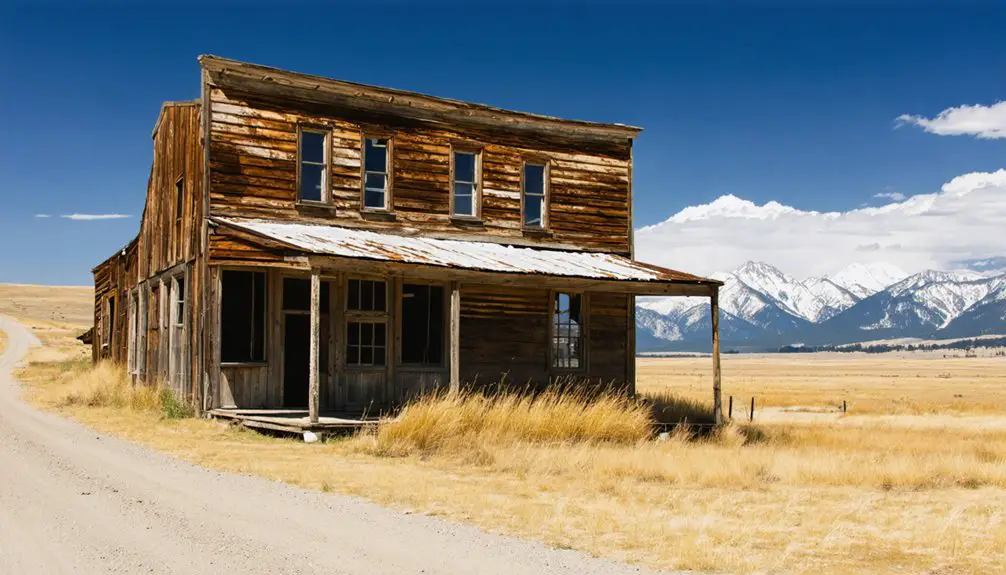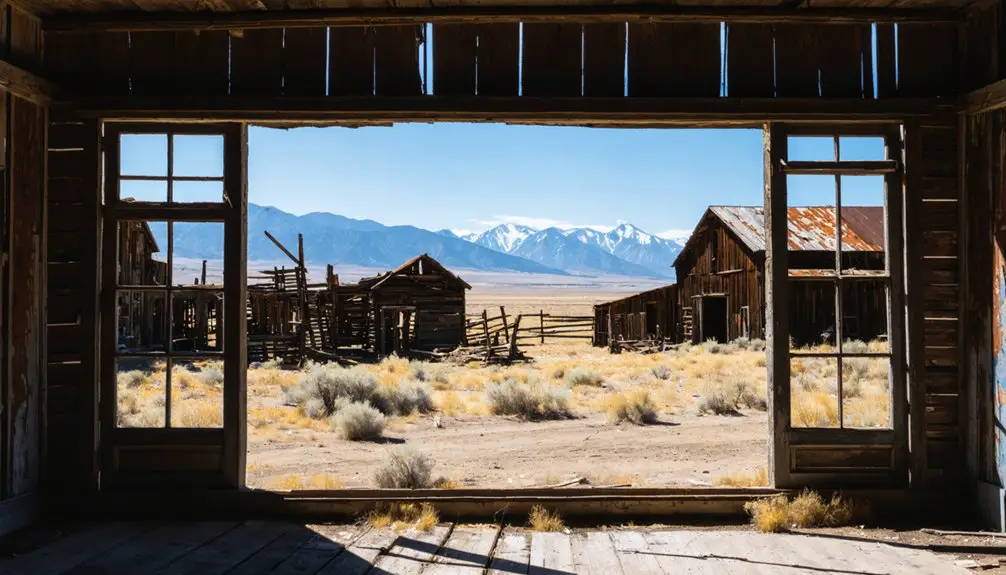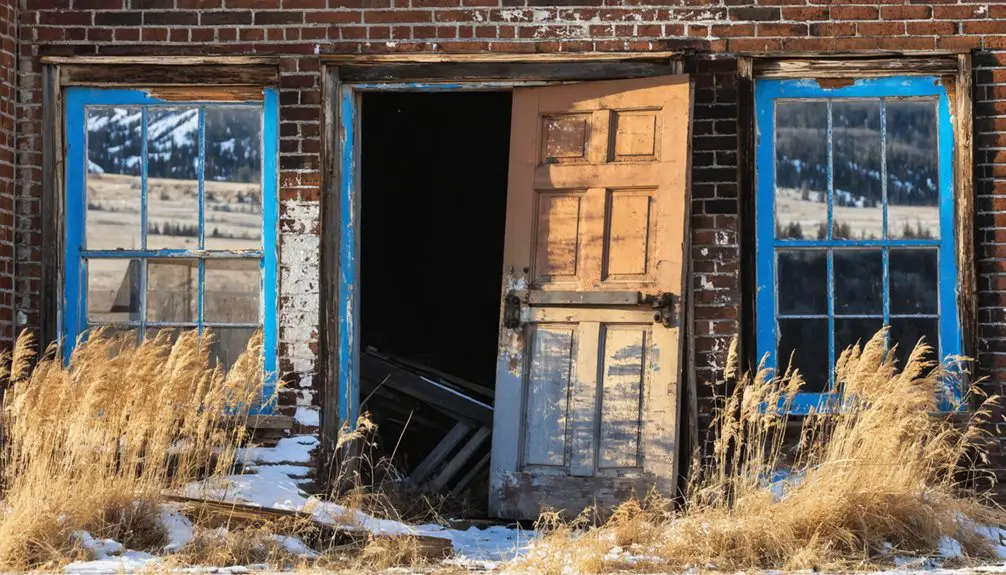You’ll find Bean’s ghost town remnants in Central Montana, where a thriving community of 10,000 once prospered during the gold rush era. Ben and Mary Bean’s 1915 land donation established essential infrastructure, including a post office, school, and hotel, serving sheep ranchers and homesteaders. Today, scattered foundations and deteriorating buildings mark where pioneers faced harsh winters and crop failures. The site’s architectural ruins hold untold stories of frontier determination and resilience.
Key Takeaways
- Bean originated during Montana’s late 19th-century mining boom and grew to 10,000 residents during peak gold prospecting periods.
- Ben and Mary Bean’s 1915 land donation established crucial infrastructure including a post office, school, hotel, and general stores.
- Architectural remains include foundations, outbuildings, assayer’s offices, and blacksmith shops from the early 1900s.
- The town served as an important hub for sheep ranchers and homesteaders accessing essential services in Central Montana.
- The settlement’s deteriorating structures reflect the boom-and-bust cycle that ultimately led to its abandonment as a ghost town.
The Birth of a Prairie Settlement
As Montana Territory emerged in 1864, the waves of settlement that would shape Bean’s prairie community followed established patterns of westward expansion.
Like many homesteaders drawn to Montana’s plains, you’d have found settlers facing typical prairie challenges: scarce timber for building, long distances to supplies, and the need to adapt to semiarid farming conditions.
You’d have witnessed the familiar progression of early settlement growth, with homesteaders claiming their 160-acre parcels under the Homestead Act.
They’d build sod houses while hauling lumber from distant sources, establish essential structures like barns for livestock survival, and work to cultivate the tough prairie soil.
These pioneers supplemented their diets with local game while developing grain fields, embodying the self-sufficient spirit that marked Montana’s territorial expansion. The early settlers’ arrival followed the historic Louisiana Purchase Treaty of 1803, which had secured these lands for American settlement.
The establishment of nearby Fort Benton served as a crucial trading post and river port, providing vital supplies to the growing settlement.
Life in Early 20th Century Bean
By the dawn of the 20th century, Bean’s early homesteaders found themselves caught in the unpredictable rhythms of prairie life.
Life on the frontier ebbed and flowed like prairie grass, as Bean’s settlers adapted to nature’s unpredictable ways.
You’d have witnessed community resilience as settlers banded together to survive harsh winters and crop failures on the semiarid plains. Initial bumper crops and high wheat prices lured hopeful farmers, but agricultural challenges soon followed with persistent drought cycles testing their determination. The severe drought conditions of the 1920s forced 60,000 rural Montanans to abandon their homesteads by 1930.
Daily life centered around the local school, church, and general store, where you’d exchange news and supplies with neighbors. The railroad’s arrival opened crucial trade routes, though primitive roads still limited travel. The completion of the Mullan Road in 1860 had established an important transportation link between Fort Benton and Walla Walla.
You’d have relied heavily on self-sufficiency, supplementing farming with livestock grazing while dealing with isolation and demanding manual labor. Banking and mercantile establishments, run by pioneering families like the Conrads, provided essential services to keep the community functioning.
Traces of a Vanished Community
You’ll find the scattered foundations and outbuildings of Bean’s original settlement dating to the turn of the 20th century, with rusty metal parts and rotted wooden boards offering glimpses into the lives of early residents.
The town was established by sheep ranchers who saw potential in serving the growing homesteader population. Between these silent ruins, artifact sites reveal the practical realities of frontier life through evidence of wagon use, mule transport, and essential storage areas near the creek. Similar to Virginia City’s period displays, visitors can piece together daily routines from the remaining items and structures.
The remaining structural footprints and weathered remnants stand as physical testimony to the mining community‘s brief but significant presence in Montana’s wilderness.
Scattered Buildings Tell Stories
The scattered buildings of Bean, Montana tell compelling stories of frontier life through their weathered walls and modified structures.
You’ll find architectural remnants that reveal how residents adapted their spaces over time, creating unique layouts that served multiple purposes. These building stories are written in the remains of assayer’s offices, blacksmith shops, and modified homes with their surviving brick chimneys. Like many ghost town artifacts, these structures provide valuable insights into historical life during Montana’s mining era. The town’s miners earned about three dollars per day working in the local mines.
Walking through Bean’s remains, you’ll discover how the community organized itself, with structures strategically placed along Main Street reflecting day-to-day patterns of life.
The deteriorating cabins and commercial buildings stand as silent witnesses to the boom-and-bust cycle that ultimately led to the town’s abandonment. Each crumbling wall and unstable chimney provides a tangible connection to the harsh realities of 19th-century frontier existence.
Life Between The Ruins
Although Bean’s ruins now stand silent, traces of its vibrant community life remain visible between the weathered structures.
You’ll find evidence of community resilience in the remnants of small businesses that once supported up to 1,000 residents – from livery stables to barber shops. Like Garnet Ghost Town, Bean offered visitors a chance to explore its history through guided school tours.
Between the buildings, cultural memory echoes through spaces where saloons and bawdy houses once provided entertainment after long days of mining. Similar to Bannack’s peak era, the town swelled to ten thousand residents during the height of gold prospecting.
Like many Montana mining towns, Bean’s social fabric was woven through its union hall, school, and gathering spots where residents found stability despite harsh conditions.
You can still sense how the community adapted to challenges, from the simple construction of their homes to the establishment of essential services that kept the town functioning until precious metals and prospects ran dry.
Silent Prairie Foundations Remain
Physical traces of Bean’s structures now fade into Montana’s vast prairie landscape, offering subtle clues to its once-bustling existence.
You’ll find building footprints and cellar depressions hidden beneath prairie grasses, while scattered foundation rocks and mining debris mark where homes and businesses once stood. Ghost town archaeology reveals a community built without permanent foundations, as miners prioritized mineral extraction over lasting infrastructure.
Time and nature conspire against foundation preservation, with seasonal rains, frost heaving, and wind erosion steadily erasing Bean’s remnants.
Yet beneath the soil, broken tools, nails, and household artifacts tell stories of former residents. Modern techniques like ground-penetrating radar help locate buried foundations, while mapping surveys document these vanishing traces before they disappear completely into the prairie’s embrace.
The Bean Family Legacy
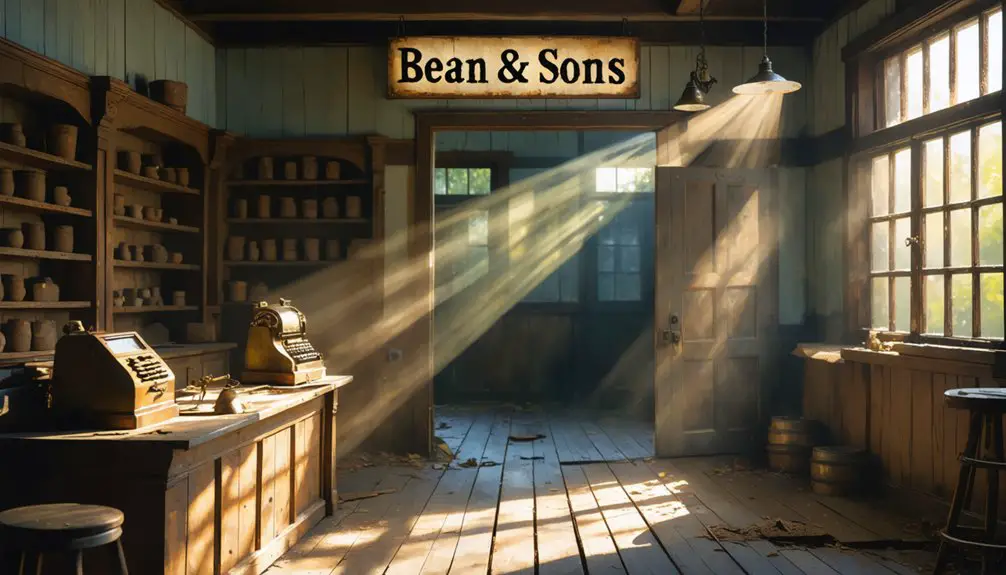
You’ll find the Bean family’s most enduring contribution in their gift of substantial ranchland that helped establish the town’s initial infrastructure.
Their expertise in sheep ranching shaped the region’s agricultural identity, with their flocks grazing the surrounding prairies for decades.
Through their active involvement in building schools, churches, and community gathering places, the Beans transformed an isolated prairie settlement into a close-knit frontier community.
Pioneer Family’s Land Gift
In 1915, Ben and Mary Bean made a lasting impact on Central Montana’s development when they donated a significant portion of their sheep ranch to support the region’s growing homesteader population.
Their land donation laid the foundation for Valentine, Montana, a town that would emerge about 20 miles north of Winnett.
The Beans’ gift proved crucial for building the community’s infrastructure, enabling the construction of a post office, school, hotel, lumber yard, and two general stores.
You’ll find that their contribution went beyond just providing space – it created a crucial hub where dispersed sheep ranchers and homesteaders could access essential services, including medical care from the town’s doctor.
This strategic land gift exemplified how pioneer families actively shaped Montana’s rural settlements, fostering economic growth and social connections in the early 1900s.
Sheep Ranching Heritage
Montana’s sheep ranching legacy took root in the 1860s, when mining camps‘ growing demand for meat spurred the industry’s development across the territory. The Bean family, like many pioneering ranchers, contributed to Montana’s rise as the nation’s top sheep-producing state by the early 20th century.
- You’ll find the Bean ranch followed traditional patterns of adapting to harsh winters through strategic grazing of native bunchgrasses and implementing winter feeding practices.
- They faced common challenges in securing skilled laborers for sheep shearing operations.
- Their wool production connected to eastern wool markets through expanding rail networks.
- They weathered the shift from open range grazing to more structured land management.
The family’s resilience through market fluctuations and environmental challenges exemplifies the adaptability that defined successful Montana sheep operations, preserving important ranching traditions in the Beaverhead Valley region.
Building A Prairie Community
Beyond their sheep ranching success, the Bean family played an essential role in establishing a self-sustaining prairie community.
You’ll find their community resilience reflected in the practical buildings they constructed – modest cabins with sod roofs and wood stoves that withstood Montana’s harsh winters. They demonstrated agricultural innovation through their balanced approach of wheat cultivation and cattle raising, ensuring both food security and farm labor needs.
Their homestead became a hub of rural life, connected to neighboring families by dirt roads that stretched across vast acreages.
Like other settlers, they helped establish essential community infrastructure including a one-room schoolhouse, contributing to local education and social cohesion.
Despite the challenges of isolation and environmental hazards, they created a lasting legacy that exemplified frontier determination.
Homesteading Culture and Daily Life
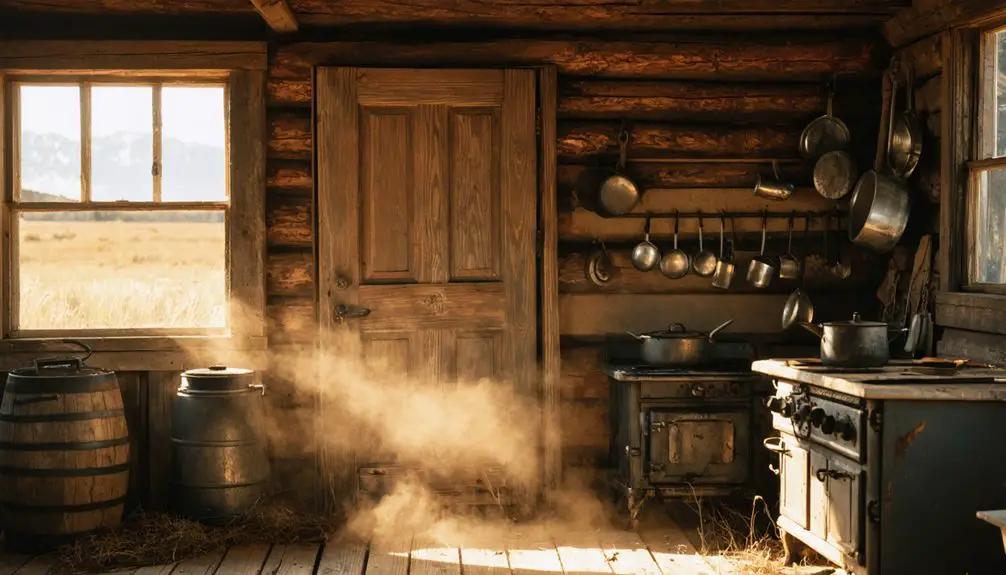
While the Homestead Act of 1862 established the legal framework for settling Montana’s frontier, daily life for homesteaders revolved around intensive agricultural labor and community cooperation.
You’d find yourself adapting to Montana’s harsh climate while trying to cultivate wheat and other staple grains using modern farming equipment. Agricultural innovations helped combat homesteading struggles during the favorable wet cycles of 1909.
- You’d need significant capital to purchase essential tools and equipment, often from railroad companies.
- Your survival depended on forming tight-knit communities to share resources and labor.
- Schools, churches, and local commerce became essential hubs for social cohesion.
- Women played important roles in both household management and independent farming operations.
The railroad served as your lifeline, connecting your homestead to crucial markets and supplies.
From Bustling Town to Historical Site
As the regional mining boom swept through late 19th-century Montana, Bean emerged as a promising settlement driven by gold and silver discoveries.
You’ll find its mining history woven into the fabric of Montana’s resource-driven expansion, where prospectors and settlers carved out a life amid harsh frontier conditions.
Despite the community’s resilience, Bean couldn’t escape the fate that befell many mining towns.
When ore yields dropped and transport costs climbed, businesses shuttered and residents departed.
By the mid-20th century, Bean had transformed from a bustling hub into a ghost town.
Today, you’ll discover deteriorating wooden structures and scattered ruins, largely reclaimed by nature.
While it lacks the formal preservation efforts of places like Bannack State Park, Bean remains accessible via dirt roads, offering you a raw glimpse into Montana’s boom-and-bust mining era.
Frequently Asked Questions
Are There Any Documented Paranormal Activities or Ghost Sightings in Bean?
Despite swiping through every paranormal database, you won’t find documented ghost encounters or spirit sightings in Bean. Unlike nearby Bannack’s well-known hauntings, Bean hasn’t produced any verified supernatural reports.
What Natural Disasters or Specific Events Contributed to Bean’s Abandonment?
You’ll find that severe flood damage to Bean’s infrastructure combined with the broader mining decline of the early 1900s dealt the final blows to this once-thriving settlement’s existence.
Did Bean Have Its Own School System During Its Active Years?
Ever wonder about frontier education? While you’d expect a mining town to have a school, there’s no documented evidence of Bean’s school history or education system in available historical records.
Were There Any Notable Crimes or Lawlessness Reported in Bean?
You won’t find specific documented crime history or dedicated law enforcement records for Bean, though it likely experienced typical frontier lawlessness similar to nearby mining settlements like Bannack’s infamous outlaw activities.
What Happened to the Residents of Bean After They Left?
You’ll find most residents relocated to nearby Montana towns like Missoula and Helena, seeking mining work or new opportunities. Their relocation stories reflect a community impact that scattered families across the region.
References
- https://catchcarri.com/trip-ghost-towns-tell-montanas-storied-past/
- https://www.ktvq.com/news/local-news/trivia-history-life-in-valentine-ghost-town
- https://www.youtube.com/watch?v=hTjid_kL23M
- https://www.centralmontanaprospectorscoalition.com/treasure-hunting-year-1/bacon-and-beans/
- https://www.youtube.com/watch?v=UOGGzyNnevc
- https://en.wikipedia.org/wiki/History_of_Montana
- https://www.britannica.com/place/Montana-state/History
- https://www.clengpeerson.no/step-by-step-migration-to-montana/
- https://en.wikipedia.org/wiki/Great_Plains
- https://opi.mt.gov/Portals/182/Page Files/Indian Education/Social Studies/K-12 Resources/Tribal Histories Companion DVD.pdf
